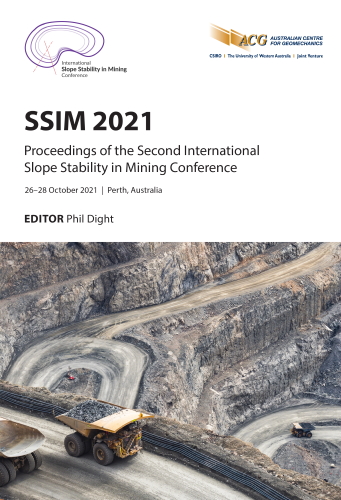InSAR monitoring guidelines: using simple to use decision trees – an owner's perspective

|
Authors: Desjardins, M; de Graaf, PJH |
DOI https://doi.org/10.36487/ACG_repo/2135_10
Cite As:
Desjardins, M & de Graaf, PJH 2021, 'InSAR monitoring guidelines: using simple to use decision trees – an owner's perspective', in PM Dight (ed.), SSIM 2021: Second International Slope Stability in Mining, Australian Centre for Geomechanics, Perth, pp. 185-198, https://doi.org/10.36487/ACG_repo/2135_10
Abstract:
Interferometric synthetic aperture radar (InSAR) application has recently benefited from an increased number of service providers (with more diverse satellite constellations), advances in algorithm processing methods and, with reductions in costs, is becoming a widely accepted method of surface deformation monitoring in the mining industry. InSAR monitoring is consequently being applied to a wide array of mine infrastructure and geotechnical risk management scenarios ranging from construction to operating and closed mines, including natural slopes traversed by mine access roads, rail and pipelines, to engineered open pits, waste dumps and tailings dams, as well as identification of subsidence and onset of potential collapse due to either active or legacy underground mining and/or karstic terrain sinkhole development. With this increased interest from a growing array of diverse technical disciplines, it has been shown that InSAR monitoring is complex and there are many variables to consider and levels of monitoring possible. Furthermore, making sense of vendors’ claims on system deliverables versus demonstrated outcomes can be challenging. These aspects need to be considered and aligned with the anticipated mode of instability, size, magnitude and rate of movement, and the business risk. Using a premium InSAR product (as high resolution data with two look directions and high frequency reports) when budget is not a limiting factor or using a budget constrained product (such as low resolution freely available Sentinel data), unless appropriately matched to the business risk profile (and deformation characteristics), will likely lead to underwhelming and possibly misleading results. This paper describes how decision trees were developed to assist in selecting the level of InSAR monitoring considering the asset infrastructure risk and the physical characteristics of the area of interest. The decision trees were built such that the user, without extensive technical knowledge of how InSAR functions, can make an independent evaluation of what InSAR product is adequate. A simple cost versus risk trade-off tool is discussed, outlining how the decision trees were developed to determine whether InSAR would be a viable solution at the site and what the appropriate resolution, acquisition frequency, report frequency, and orbit/s should be. This provides a consistent framework for firstly evaluating and matching monitoring rigour with geotechnical risk, secondly a process to facilitate alignment and ideally optimisation of monitoring outcomes between disciplines, and finally for communicating these to management to demonstrate an effective business case for monitoring.
Keywords: InSAR, slope stability, tailings dams, displacement monitoring, risk management, decision tree
References:
Ferretti, A, Monti-guarnieri, A, Prati, C & Rocca, F 2007, InSAR Principles: Guidelines for SAR Interferometry Processing and Interpretation, ESA Publications, Auckland.
Morgan, JL, Colombo, D & Meloni, F 2019, ‘InSAR tools for risk assessment over mine assets’, in J Wesseloo (ed.), MGR 2019: Proceedings of the First International Conference on Mining Geomechanical Risk, Australian Centre for Geomechanics, Perth, pp. 159–170,
Morgan, J, Boudreau, A, Verdugo, MA, Meloni, F & Colombo, D 2020, ‘New satellite sensors for monitoring mining areas: a look at the future’, in PM Dight (ed.), Slope Stability 2020: Proceedings of the 2020 International Symposium on Slope Stability in Open Pit Mining and Civil Engineering, Australian Centre for Geomechanics, Perth, pp. 1521–1530,
Sharon, R & Eberhardt, E 2020, Guidelines for Slope Performance Monitoring, CSIRO Publishing, Collingwood.
© Copyright 2024, Australian Centre for Geomechanics (ACG), The University of Western Australia. All rights reserved.
View copyright/legal information
Please direct any queries or error reports to repository-acg@uwa.edu.au
View copyright/legal information
Please direct any queries or error reports to repository-acg@uwa.edu.au